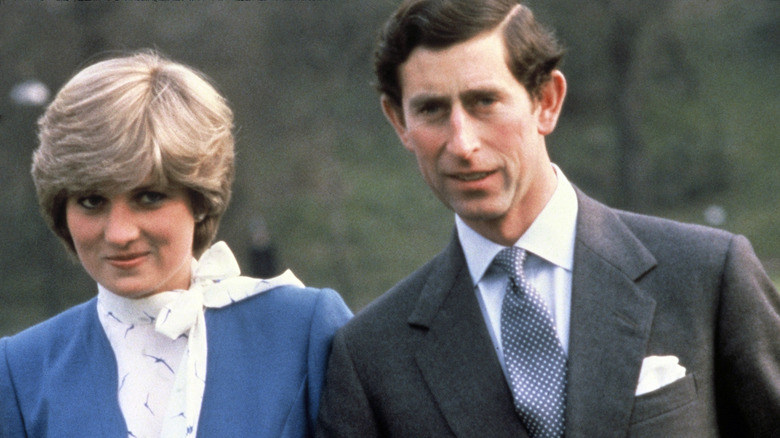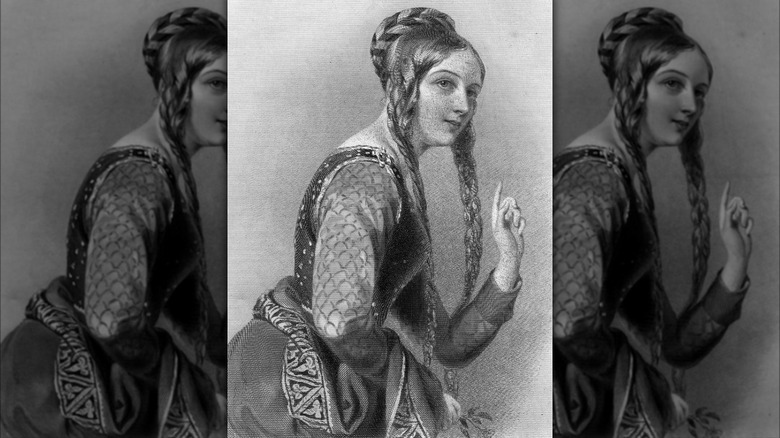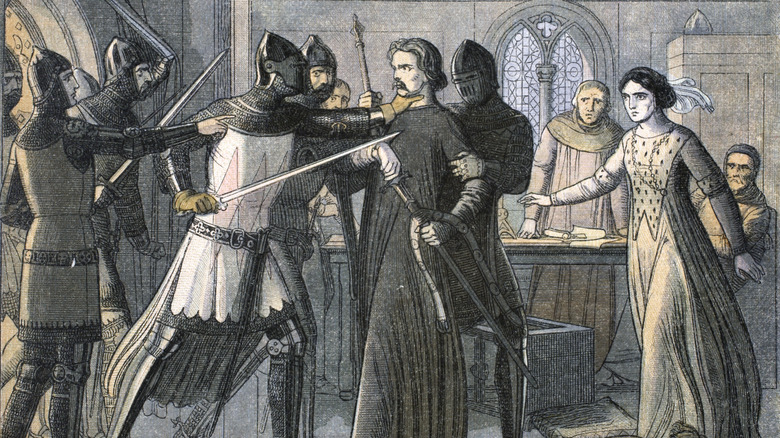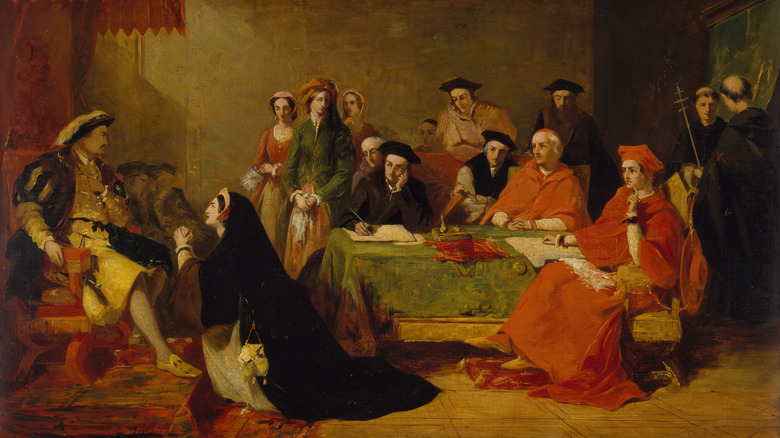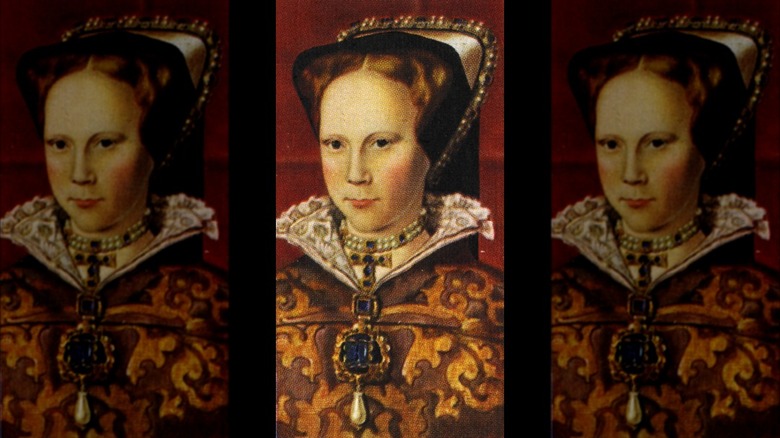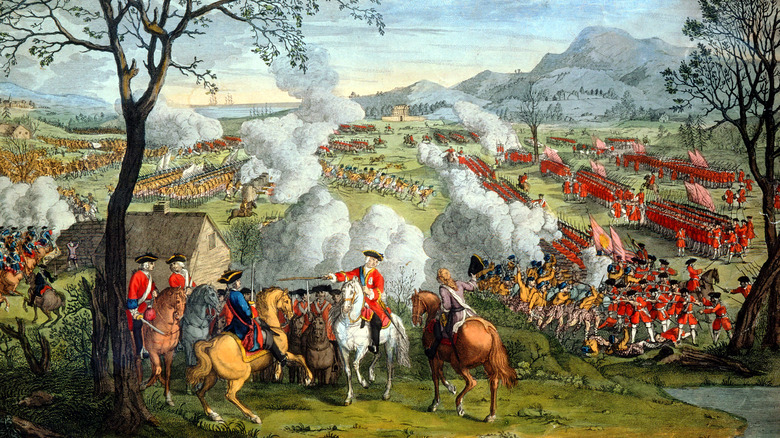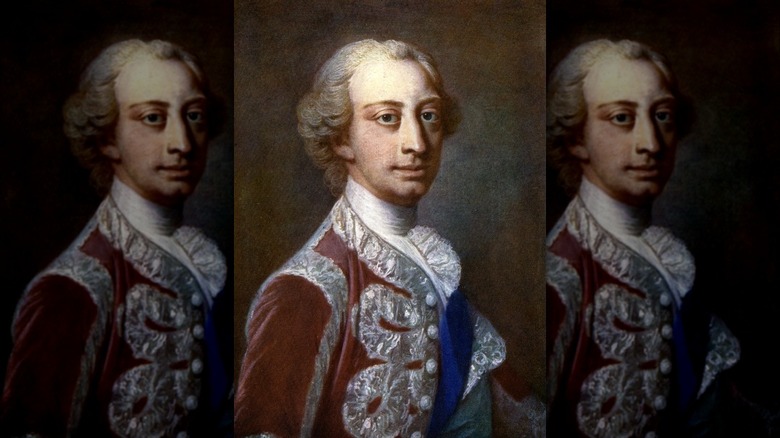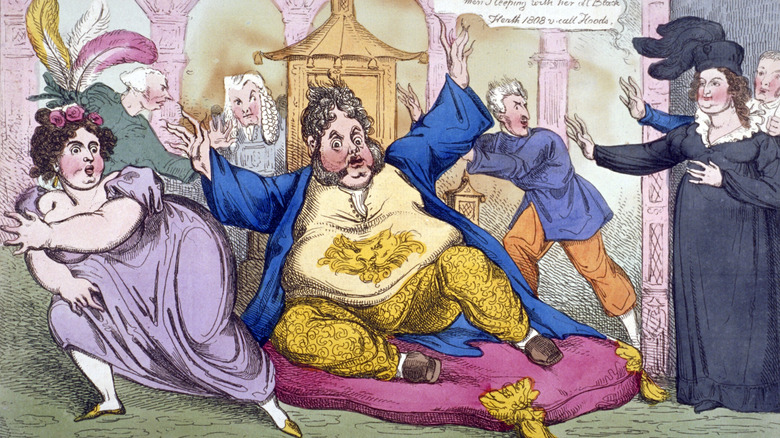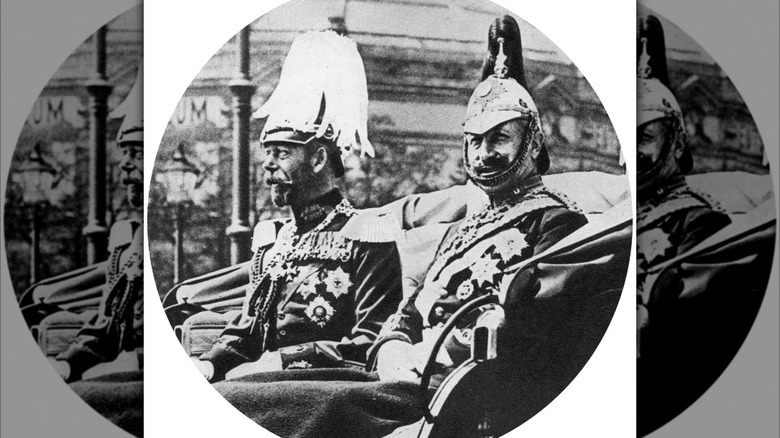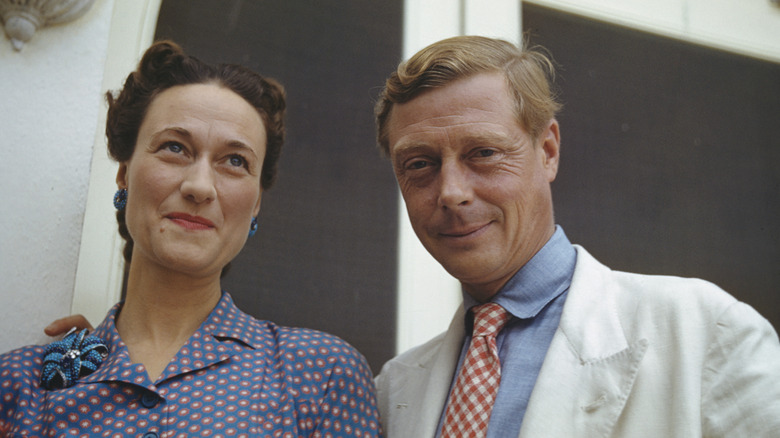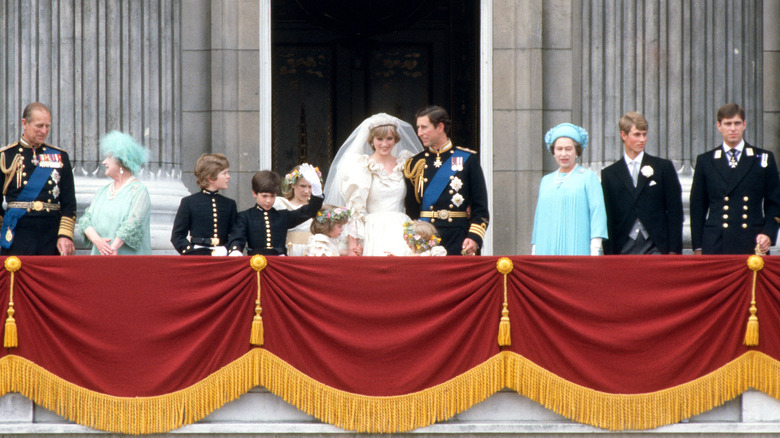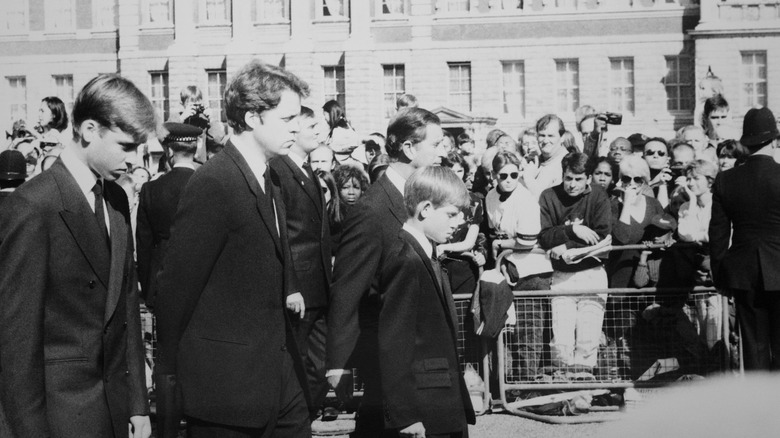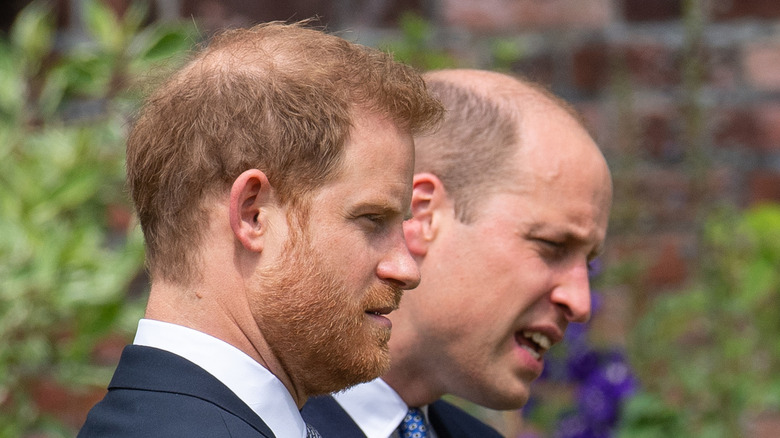British Royal Feuds That Got Out Of Hand
Recently, the British royal family has been in the tabloids over feuds with Prince Harry and Meghan Markle on one hand, and with everyone else on the other. Fortunately, the feuds today are not quite as consequential as in the past. With the exception of the problems between Diana and Charles, they generally have not ended in death and bear more resemblance to a bad reality show than an actual political conflict. In ages past, however British (and English before that) royal feuds could get quite nasty and violent, with far higher stakes than the loss of an inconsequential royal title.
British history is full of royal feuds dating back to the Middle Ages. Kings, queens, and princes frequently sought to one-up each other, usually for the throne or greater influence at court. Over time, the consequences of such feuds became less fatal. What might have ended in murder or execution in one time period had tended to end with abdication, exile, or repudiation in more recent centuries. Here are some of the most fascinating, consequential, and absurd royal feuds to unfold on the British Isles.
Eleanor of Aquitaine vs. Henry II
According to OSU's history department, Eleanor of Aquitaine's first marriage to Louis VII of France ended in divorce, which the chronicler William of Newburgh (via Fordham) noted was against the wishes of the church. Then she married Louis' rival, the Norman duke Henry in 1152, who later became Henry II of England.
Eleanor's second marriage did not fare much better than the first. Despite giving Henry eight children, the king's eye still wandered to other women. Eleanor's tolerance snapped when Henry took the beautiful Rosamund Clifford as his mistress, according to the BBC, even building her a rural retreat and private bath of her own. So Eleanor returned to her lands in France and began plotting her revenge.
She got her chance in 1173. William of Newburgh writes that a dispute over her lands in France exploded into a rebellion against the king led by his son Prince Henry. Eleanor provided a base of operations, money, and supplies. But after the rebellion failed, Henry imprisoned his wife in various castles for 15 years, allowing her out only on official excursions – and she was closely monitored.
Eleanor eventually got her revenge. Her son Richard rebelled against his father in 1189, again using his mother's lands as a base. According to William of Newburgh, Henry resisted until Richard and Eleanor convinced his youngest and favorite son Prince John (of Robin Hood fame) to join the revolt. Henry died, Richard became king, and Eleanor became "Queen of England, his much loved mother."
Edward II vs. Isabella of France
According to English Monarchs, the ambitious French princess Isabella should have been thrilled with marriage to the handsome and powerful Edward II of England. But Edward enjoyed extremely close and probably sexual relationships with men as well. Even at his own wedding, sat with his alleged lover, a knight named Piers Gaveston, rather than his new bride. He gifted Isabella's jewelry to Gaveston, who mocked the queen by wearing it publicly. According to Historic UK, a series of other lovers followed, some of whom became very powerful – and hated – for their closeness with the king.
Despite bearing four children, Isabella was "the most wretched of wives," calling her husband a "stranger in [her] bed." Her patience snapped in 1322. After a defeat at Byland Moor, Edward left Isabella at the mercy of the Scottish army while he, his lover Hugh Despenser, and his army retreated back to England. She barely escaped capture and began plotting Despenser's downfall. In response, Edward took away her lands.
A furious Isabella had had enough. If her husband was going to be adulterous, so was she, openly taking Edward's enemy Earl Roger Mortimer as her lover. According to the National Portrait Gallery, the ensuing revolt dethroned Edward II for his son Edward III. Isabella and Mortimer ruled as his regents. Now, the whole feud could have ended there, but Isabella wanted revenge. Hugh Despenser was hanged, drawn, and quartered as entertainment while she feasted. Edward II disappeared, and the first records of his death say he was strangled, but later a rumor started that Isabella had him killed by sodomizing him with a hot iron rod (most historians dismiss this story today).
Catherine of Aragon vs. Henry VIII and Anne Boleyn
Catherine of Aragon, Henry VIII's first wife, was devoted to her husband. Yet, their once-happy marriage disintegrated into a one-sided feud that ended in her death. According to the HRP Foundation, the Spanish princess had only given Henry a daughter named Mary and lost at least five to miscarriage or illness. So when the young and stylish Anne Boleyn entered the scene, Henry decided he wanted the youthful lady-in-waiting as a wife. Catherine would not go quietly, and according to HRP, she had the Catholic Church on her side. Catholicism forbids divorce, so Henry had to get an annulment by proving that his marriage to Catherine had never existed in the eyes of God.
Catherine had been previously married to Henry's late brother Arthur. If the marriage had been consummated, Henry could get an annulment on the basis of Catherine's physical relations with a blood relative of Henry's. Catherine insisted the marriage had not been consummated. (The pair were only married for six months when they were both about 15 years old.) So Henry's allies humiliatingly questioned Catherine about her sexual history with Henry's brother.
When the interrogations didn't break her, Henry expelled Catherine from court in 1533 and denied her contact with their daughter Mary. The ordeal broke Catherine, who died in 1535. According to imperial ambassador Eustace Chapuys (via On the Tudor Trail), Catherine forgave her husband, begging him to look after Mary and his own soul, lest his desires lead him to Hell. Henry's reaction was to praise God, while Anne wore yellow to mock her rival's death in celebration rather than mourning. All may be fair in love in war, but was that last bit really necessary?
Mary Tudor vs. Anne Boleyn
In dethroning Catherine of Aragon, Anne Boleyn gained herself a new enemy – her stepdaughter Mary Tudor. According to historian Melita Thomas (via On the Tudor Trail), Mary was a pawn in the feud between her parents. Although Henry publicly ignored Mary to placate Anne, he loved his daughter and continued to spend time with her privately.
Anne waged war against her teenage stepdaughter, who responded in kind. First, she demanded Mary surrender her personal childhood belongings to her new half-sister Elizabeth. After she refused, her father forced her to join Elizabeth's household and acknowledge her half-sister (whom she viewed as illegitimate) as heir. She refused that too, so her father took away her title of "princess" while Anne appointed her own aunt as Mary's governess – just to annoy her. According to History Extra, Mary responded by point-blank refusing Anne's summons to acknowledge her as queen.
Henry eventually began experiencing remorse over the treatment of his daughter, while Anne, realizing she was getting nowhere, tried reconciliation. Mary refused to accept Anne as a stepmother after her own mother died in 1536, and soon, Anne's days were also numbered. Anne was charged with adultery and executed the same year. Before she died, she sent Mary a message begging for forgiveness. Mary's reaction is unknown, but, as History Extra notes, she bore no ill-will to her half-sister Elizabeth, suggesting that perhaps she forgave her stepmother in the end.
The Jacobite Rising
According to the National Army Museum, Great Britain passed to the German Elector of Hanover George I in 1714 after the Protestant Stuart line died out. But the Catholic Stuarts, barred from succession due to the Act of Settlement, resolved to retake the throne by force.
The war against the "Hanoverian usurpers" fell to Charles Edward Stuart (a.k.a. Bonnie Prince Charlie). In 1745, he raised a revolt in the Highlands and marched south to the sound of martial ballads mocking their enemies. As Scots are known for, the Jacobite ballads were full of creative insults for the Hanoverian monarch George II, whom the Jacobites referred to as the "wee German lairdie" in a song of the same name (via Rampant Scotland). With Highland bravado, the Jacobites bragged that the "foreign trash" and the "feckless German lairdie" did not have the courage to march north and face the highlanders personally. Thus, the highlanders would crush him and his cowardly foreign forces.
It is unknown what George II's reaction to Scottish bravado was, but given his choice of commander to crush the rebellion, it probably wasn't positive. According to the University of Nottingham, George appointed his son William Augustus, who defeated Charles at Culloden in 1746. Matters might have ended there, but according to the BBC, William hated Scotland. Unable to capture Charles, he humiliated his Gaelic supporters, banning Scottish dress, disarming the clans, burning their villages, and, according to the Guardian, suppressing Scottish Gaelic in favor of English. Thus, Scotland's Celtic identity was destroyed as a result of a feud over the throne of England.
Prince Frederick vs. George II
According to English Monarchs, George II and his queen, Caroline of Ansbach, were strong-willed, somewhat arrogant types that brooked no dissent. Their character led to a strained relationship with their son and heir Frederick, Prince of Wales. As the Volume of the Walpole Society explains, George's jealousy of his son led to a strained relationship in which even Frederick's own mother wished him dead.
George refused to allow his son to marry until 1736, when he matched Frederick with Augusta of Saxe-Gotha. Now, the problem: George II had enjoyed an allowance of £100,000 as Prince of Wales but only gave his son £25,000. Frederick demanded the same as his father, who denied him, compromising on £50,000. This dispute undoubtedly led to the next one, where things went too far.
According to Georgian Papers, Princess Augusta was to give birth before the family at Hampton Court Palace, as was custom. Instead, the prince lied about her due date and spirited her out to St. James' Palace, preventing his parents from attending the birth. In response, Queen Caroline called her new granddaughter a "poor, ugly, little she-mouse." Fed up with her son, per English Monarchs, Caroline called him "the greatest a** ... liar ... canaille ... and beast" in the world and wished "he was out of it." The Queen did not live to regret her words. She died in 1737. But they did come true. In 1751, Frederick died of a lung abscess, leaving his son Prince George as heir.
George IV vs. Queen Caroline
Womanizer George, Prince of Wales (the future George IV), per the Twickenham Museum, secretly settled down with the 27-year-old Catholic widow Maria Fitzherbert. But according to Historic UK, their lifestyle landed Prince George in £630,000 of debt. Parliament offered him a way out. If he married and produced an heir, Parliament would absolve his debts.
George was matched with the "short, fat, [and] ugly" Princess Caroline of Brunswick. While this description may be exaggerated, historian E.A. Smith's book "George IV," notes that although Caroline was actually pretty with a good figure, she lacked any sense of social propriety. The fastidious and fashionable George found her repulsive and humiliated her from the start. First, he sent a mistress to receive her upon arrival in London. He then spent three days before the wedding drinking and passed out on their wedding night from the stupor. After one year, he repudiated her and, per the U.K. Parliament, barred Caroline from seeing their daughter Charlotte. It was so bad, that their relationship became the subject of political cartoons (such as above). After their only child's death in 1817, George sought a divorce.
Divorce was only possible if Caroline's infidelity could be proven. Fortunately for George, there were plenty of rumors circulating about her promiscuous lifestyle in Italy. Despite numerous witnesses, Caroline survived the divorce proceedings thanks to public support. In revenge, her husband locked her out of their coronation in 1821 at bayonet point. Humiliated, she fell ill and died three weeks later. With no heir, the throne passed to George's brother William IV, and eventually, their mutual niece Queen Victoria.
Kaiser Wilhelm II of Germany vs. the British Royal Family
According to the journal "History," Queen Victoria arranged her daughter's German marriage to cement peace in Europe through an Anglo-German alliance. But her grandson Kaiser Wilhelm II did not share her views. Per the MA thesis "Royal Pains," his anti-British sentiments irritated his grandmother to no end. When Queen Victoria said he needed a "good skelping" to set him straight, Wilhelm called grandmother a "hag" whose time had come to die. Victoria in turn disinvited her grandson from British social functions (including her own birthday) for such insults.
Once Victoria died, Ango-British royal relations went off the rails. Kaiser Wilhelm, bankrolled a series of (mostly true) attacks on Edward VII's dissolute lifestyle in the British press, calling the British king "satan." The attacks initiated a back-and-forth of insults between uncle and nephew. When Edward called Wilhelm Europe's "enfant terrible," Wilhelm called him an idiot. When Wilhelm barred his son from visiting Britain, Edward barred his own son from attending the German prince's wedding.
This one truly went too far. This dispute might have been comical had it not helped ignite World War I, which resulted in over one million deaths. Even after all the death and destruction, per the "The Last Kaiser," Wilhelm never got over his hatred for Britain, calling the country's ruling class allies of "liberalism, Satan, and ... the Antichrist" that had conspired to bring war and ruin upon Germany.
Edward VIII vs. George VI and family
Edward VIII and his brother George were close growing up. According to the Daily Mail, a letter unearthed in Australia proved that Edward had even helped his brother sleep with a married woman in 1919 by keeping her husband occupied with golf. According to Vanity Fair, the relationship soured in 1936. Edward was a good-looking and charismatic man that had his pick of women. But to his family's horror, he fell for twice-divorced American socialite Wallis Simpson, an unacceptable candidate for queen consort, they thought. So Edward abdicated the crown to marry her.
The terms of his abdication set off a feud with his brother (now George VI). George refused to grant Simpson any sort of title nor increase Edward's allowance. As it turned out, Edward had lied about his financial situation, claiming to be much poorer than he actually was. Queen Elizabeth (mother of the current one) called Wallis "that woman," while the duchess returned the favor by calling the queen "the fat Scottish cook." Meanwhile, Edward referred to his nieces and other female relatives as "thin-veined ice-b****es."
The feud got worse once politics became involved. The former king courted Nazi Germany and other European fascist states, possibly with treacherous intent. So George exiled him to the Bahamas, a then-colony that Edward compared to Napoleon's imprisonment on Elba. Eventually, George died in 1952 a national hero for his wartime conduct, burned out from the stress of kingship. Queen Elizabeth II blamed her uncle, who despite attending the funeral, did not show a shred of sadness for his formerly closest companion.
Princess Diana vs. the Queen Mother
It was generally well known that Princess Diana was not happy in her marriage to Charles. In a bombshell 1995 interview with BBC's "Panorama" (via People), she leveled veiled criticism at her husband's affair, the stress that resulted in an eating disorder, depression, and self-harm. In airing much of the royal family's dirty laundry in relation to herself, the interview was considered a PR disaster for the rest of the Royal Family, which sought to maintain a clean, dignified public image.
As soon as word got out that Diana's interview was hitting the national media, Elizabeth the Queen Mother tried getting ahead of any possible scandal. According to historian Robert Hardman (via Daily Mail), the 95-year-old matriarch scheduled a hip surgery for the day before the interview was set to air. At her age, any invasive surgery naturally carried a risk of death. But she took things a bit too far, reasoning that if she died on the operating table, she could knock Diana off primetime television and the front pages of the tabloids and lessen the effect her revelations had on the royal image.
In the end, it failed, since she survived the surgery and the documentary blew up the next day. Given how badly the royals treated Diana, however, her intent was messed up, to say the least. Was the royal image really worth more than the well-being of a family member?
Charles Spencer vs. Prince Charles and family
Princess Diana's death in 1997 only served to divide the family further and pitted her brother Charles, Earl Spencer against her ex-husband Prince Charles and the rest of the family. The two Charles hated each other. According to journalist Emily Andrews (via the Express), Prince Charles could not help but insult the dead Diana over the phone to her brother while making preparations for her funeral. Spencer slammed the receiver down in response. Having seen the way his sister was treated, it must have hurt to hear such disrespect even in death. But he got his revenge.
Spencer decided to avenge his sister at her funeral. In her eulogy (via Town and Country), the earl waxed poetic about his sister's "natural nobility" and "classlessness." She did not need a title to generate "her brand of magic" with her family or in the world. While these words were undoubtedly true, given Diana's charity work and devotion to her children, it was also a barb at the royal family. He implied that Diana the commoner had more nobility than the blue-blooded British royals ever would – despite their fancy titles and wealth.
So who was in the wrong here? Prince Charles no doubt escalated by insulting his dead ex-wife. Did Spencer have to call out the royal family in front of Diana's children? Probably not at the funeral, but his motives are perfectly understandable. The consequences of the rift are still around today, as the two Charles refuse to even sit near each other at official functions.
Prince Harry vs. Prince William
Today, the tabloids have mostly covered the ongoing conflict between princes Harry and William. Now, it is unclear what this one is about. Tabloids such as The Express have speculated that their problems originate with Prince Harry, Duke of Sussex's decision to break with the family over his marriage to American Meghan Markle. But there is also perhaps the presence of second-son syndrome. Prince William, Duke of Cambridge will come to inherit the trappings of the king when his father and grandmother die, while Harry likely never will. (There would need to be one heck of a tragic diaster, considering he's currently 6th in line.)
Observers assumed that an early interview with both princes and their spouses showed signs of trouble. At the Royal Foundation Forum in 2018, they simply chalked up their differences to "healthy disagreements," but their awkwardness suggested that there is something more that, as of 2022, has still not been resolved.
